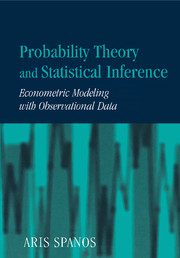Book contents
- Frontmatter
- Contents
- Preface
- Acknowledgments
- Symbols
- Acronyms
- 1 An introduction to empirical modeling
- 2 Probability theory: a modeling framework
- 3 The notion of a probability model
- 4 The notion of a random sample
- 5 Probabilistic concepts and real data
- 6 The notion of a non-random sample
- 7 Regression and related notions
- 8 Stochastic processes
- 9 Limit theorems
- 10 From probability theory to statistical inference*
- 11 An introduction to statistical inference
- 12 Estimation I: Properties of estimators
- 13 Estimation II: Methods of estimation
- 14 Hypothesis testing
- 15 Misspecification testing
- References
- Index
5 - Probabilistic concepts and real data
Published online by Cambridge University Press: 06 July 2010
- Frontmatter
- Contents
- Preface
- Acknowledgments
- Symbols
- Acronyms
- 1 An introduction to empirical modeling
- 2 Probability theory: a modeling framework
- 3 The notion of a probability model
- 4 The notion of a random sample
- 5 Probabilistic concepts and real data
- 6 The notion of a non-random sample
- 7 Regression and related notions
- 8 Stochastic processes
- 9 Limit theorems
- 10 From probability theory to statistical inference*
- 11 An introduction to statistical inference
- 12 Estimation I: Properties of estimators
- 13 Estimation II: Methods of estimation
- 14 Hypothesis testing
- 15 Misspecification testing
- References
- Index
Summary
Introduction
In completing the formalization of the notion of a simple statistical model in chapter 4 we have reached one of our primary intermediate targets. The qualifier simple is used to emphasize the fact that the model is restrictive in the sense that the notion of a random sample renders it appropriate only for observed data which can be viewed as a realization of a set of random variables which are both Independent and Identically Distributed (IID). In the next three chapters we will extend this simple model to more realistic forms of statistical models which can be used to model economic data exhibiting non-IID chance regularity patterns. Before we proceed in that direction, however, we need to solidify the ground charted so far by building a bridge between the theoretical concepts defining a simple statistical model (a family of densities, Independence and Identically Distributed random variables) and the corresponding chance regularity patterns exhibited by observed data. As argued in chapter 1, in the context of the development of probability theory, the probabilistic concepts are usually motivated by chance regularity patterns in observed data. In this chapter we consider the question of utilizing graphical displays of the observed data in order to establish their connection with the probabilistic assumptions underlying simple statistical models.
Why do we care?
As argued in the previous chapter, any form of statistical inference presupposes postulating a statistical model which provides the foundation of the empirical modeling.
Information
- Type
- Chapter
- Information
- Probability Theory and Statistical InferenceEconometric Modeling with Observational Data, pp. 190 - 259Publisher: Cambridge University PressPrint publication year: 1999
